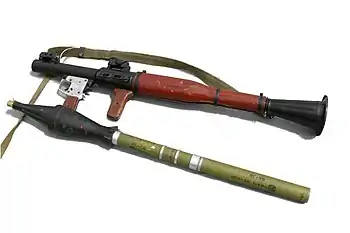Rwanda Defence Force
The Rwanda Defence Force (RDF, Kinyarwanda: Ingabo z'u Rwanda; French: Forces rwandaises de défense) is the national army of Rwanda. The country's armed forces were originally known as the Rwandan Armed Forces (FAR), but following the stopping of the 1994 Genocide against Tutsis, the victorious Rwandan Patriotic Front (Inkotanyi) created a new organization and named it Rwandan Patriotic Army (RPA). Later, it was renamed to its current name.
| Rwanda Defence Force | |
|---|---|
| Ingabo z'u Rwanda Forces rwandaises de défense Nguvu ya Ulinzi ya Watu wa Rwanda | |
 | |
| Founded | 1962 |
| Current form | 1994 |
| Service branches | Reserve Force |
| Headquarters | Post Box 23, Kigali[1] |
| Leadership | |
| Commander-in-Chief | President Paul Kagame |
| Minister of Defence | Major General Albert Murasira |
| Chief of Defence Staff | General Jean Bosco Kazura |
| Manpower | |
| Available for military service | 2,625,917 males, age 16–49[2] (2010 est.), 2,608,110 females, age 16–49[2] (2010 est.) |
| Fit for military service | 1,685,066 males, age 16–49[2] (2010 est.), 1,749,580 females, age 16–49[2] (2010 est.) |
| Reaching military age annually | (2010 est.) |
| Active personnel | 33,000[3] |
| Expenditures | |
| Budget | $91 million (2015)[3] |
| Percent of GDP | 1.1% (2015)[3] |
| Related articles | |
| History | Military history of Rwanda Rwandan Civil War Kibeho Massacre First Congo War Second Congo War Six-Day War (2000) Dongo conflict 2009 Eastern Congo offensive |
The RDF comprises:[4]
- High Command Council of the RDF
- General Staff of the RDF
- Rwanda Land Force
- Rwanda Air Force
- Individual units
- Army Band of the RDF
The Rwanda Defence Force’s mission as provided in the Constitution of Rwanda is:
- to defend the territorial integrity and the national sovereignty of the Republic;
- to collaborate with other security organs in safe-guarding public order and enforcement of law;
- to participate in humanitarian activities in case of disasters;
- to contribute to the development of the country;
- to participate in international peace-keeping missions, humanitarian assistance and training.
After it conquered the country in July 1994 in the aftermath of the Rwandan genocide of April to July 1994, the Rwandan Patriotic Front (RPF) decided to split into a political division (which retained the RPF name) and a military division, which would serve as the official army of the Rwandan state.
Defence spending continues to represent an important share of the national budget, largely due to continuing security problems along Rwanda's frontiers with the Democratic Republic of the Congo and Burundi, and lingering concerns about Uganda's intentions towards its former ally.
There is an ongoing, low-level insurgency from Rwandan rebels based in the Democratic Republic of the Congo, mainly the Forces démocratiques de libération du Rwanda (or FDLR).
The RDF is regularly deployed in peacekeeping missions in Africa. Rwanda is now one of the largest contributors of personnel on UN missions.
Historical outline 1962–1994
| Hutu militants |
|---|
| Rwandan genocide (1994) |
| Impuzamugambi |
| Interahamwe |
| Rwandan Armed Forces |
| Refugee crisis |
| RDR (1995–1996) |
| 1st and 2nd Congo War |
| ALiR (1996–2001) |
| FDLR (2000–present) |
The U.S. Army's Area Handbook for Rwanda, compiled in 1968–9, describes the security forces of Rwanda in 1969 as the 2,500 strong National Guard and the National Police, about 1,200 strong.[5] The National Guard had been established two years before independence and had gained experience by repelling small Tutsi invasions in 1963 and 1964. It was under the direction of the Minister of Defence, Juvénal Habyarimana, who also held the function of Chief of Staff of the National Guard in mid-1969. At that time it was composed of a headquarters, an intervention group (effectively an infantry battalion), five other rifle companies, and five independent rifle platoons.
The Forces armées rwandaises (FAR) was the national army of Rwanda until July 1994, when the government collapsed in the aftermath of the Rwandan genocide and the war with the Rwandan Patriotic Front/(Inkotanyi). The FAR was estimated at 7,000 strong, including approximately 1,200 members of the Gendarmerie. Elite troops included the Presidential Guard, estimated at between 1,000 and 1,300 troops, as well as the Paracommando and Reconnaissance units.[6] These two units were of battalion strength by 1994, and then counted a total of 800 troops.[7]
In response to the RPF invasion of 1990, the 5,000-man FAR rapidly expanded, with French training assistance (as many as 1,100 French troops were in Rwanda at a time[8]), to some 30,000 by 1992.[9]
The Arusha Accords, signed on August 4, 1993, laid out a detailed plan for the integration of the Rwandan Government and Rwandan Patriotic Front military forces.[10] The Rwandan government was to provide 60% of the troops for the new integrated army, but would have to share command positions with the RPF down to the level of battalion. The new army was to consist of no more than 19,000 soldiers and 6,000 Gendarmerie.[11] However radical elements within the Rwandan government were implacably opposed to implementation of the Accords and, instead, began the planning that would lay the foundations for the genocide.
The Reconnaissance Battalion's commander, François-Xavier Nzuwonemeye, and his subordinates played a key role during the genocide. Together with the Reconnaissance Battalion, the Paracommando Battalion under Major Aloys Ntabakuze and the Presidential Guard under Major Protais Mpiranya became the three most significant genocidare units.
Col. Marcel Gatsinzi was briefly named chief of staff of the Rwandan army from April 6 to April 16, 1994, but was replaced by Augustin Bizimungu, who was also promoted to major general on 18 April,[12] since Col. Gatsinzi opposed the genocide.[13] Bizimungu was only briefly chief of staff before fleeing the country. Many soldiers of the FAR have since been implicated by the International Criminal Tribunal for Rwanda in the genocide, including its leader during the genocide, Col. Théoneste Bagosora, who was chief of the cabinet (private office) of the Ministry of Defence prior to the genocide.
Many elements of the former Rwandan regime, including soldiers of the FAR, fled to eastern Zaire after the RPF victory, where they formed the Rassemblement Démocratique pour le Rwanda (RDR), which later became the Democratic Forces for the Liberation of Rwanda (FDLR), which is still active in eastern Congo's North Kivu Province.
Operations post-1994
Kibeho Massacre, 1995
A massacre of internally displaced persons involving Rwandan Patriotic Army elements, at Kibeho in southern Rwanda during April 1995. See main article Kibeho Massacre.
First Congo War, 1996 to 1997
See main article First Congo War.
Second Congo War, 1998 to 2003
See main article Second Congo War.
Circa 2000 during the Second Congo War, the Rwanda Patriotic Army unofficially admitted to having 4,000 to 8,000 troops deployed in the Congo, according to the Economist Intelligence Unit, but this was believed to be a substantial understatement.[14] The International Crisis Group estimated that the RPA has between 17,000 and 25,000 troops deployed in the Congo. In April 2001, a United Nations report on the exploitation of the Congo, said the RPA had a minimum of 25,000 troops in the Congo, an estimate the report attributes to "military specialists with a great deal of experience in the region."[15] During the deployment on DRC, Rwandan forces fought the so-called "Six-Day War" against Ugandan forces over the city of Kisangani, leaving at least 1,000 dead.
On 17 September 2002 the first Rwandan soldiers were withdrawn from the eastern DRC. On 5 October Rwanda announced the completion of its withdrawal; MONUC confirmed the departure of over 20,000 Rwandan soldiers.
Ongoing Insurgency
There is an ongoing, low-level insurgency from Rwandan rebels based in the Democratic Republic of the Congo, mainly the Forces démocratiques de libération du Rwanda (or FDLR)[16] and also Burundi (the Forces nationales de libération, or FNL).[17]
During early 2009 the RDF operated in eastern DRC against FDLR rebels in joint operations with the armed forces of the DRC. The initial 2009 deployment was code-named Operation Umoja Wetu. The RDF re-entered the DRC in 2009 to assist the DRC in putting down the Dongo Rebellion. These operations inside the DRC did not prevent cross-border attacks within Rwanda during late 2012, August 2013, December 218 and December 2019. There have also been a small number of attacks in southern Rwanda from Burundi-based rebels.
The Rwanda National Congress is another opposition group reported by the Kigali Government as carrying out attacks in Rwanda.[18][19] These include blame for grenade attacks in Rwanda between 2010 and 2014 that killed at least 17 people and injured over 400 others.[20]
Peace Support Operations
The RDF has deployed forces on a number of UN and AU endorsed peace support operations in Africa. Rwanda is now one of the largest contributors of personnel on UN missions. Deployments include:
African Union Mission in Sudan (AMIS) Units were deployed on year-long tours of duty between August 2004 and December 2007. The peak commitment was four battalions.
United Nations Mission in Sudan (UNMIS) In the first ever deployment of Rwandan personnel on a United Nations mission, a small contingent of 254 personnel was deployed for year-long tours between November 2005[21] and September 2010.
African Union/ United Nations Hybrid Mission to Darfur (UNAMID) This UN mission superseded the AU mission in the Darfur region of Sudan. Infantry battalions have been deployed, for year-long tours, between January 2008 and mid-2020. Starting with a peak deployed strength of four battalions, the numbers had declined by mid-2020 to two battalions.
United Nations Mission in South Sudan (UNMISS) In April 2012 a Rwandan contingent was deployed to this UN mission in the newly independent country of South Sudan. The deployment was continuing in mid-2020, by when an aviation unit, two infantry battalions and a Regional Protection Force battalion were deployed.
AU-led International Support Mission to the CAR (MISCA) This African Union mission to the troubled Central African Republic was joined, between January and September 2014, by a Rwandan mechanised battalion.[22][23]
United Nations Multidimensional Integrated Stabilization Mission in the Central African Republic (MINUSCA) This UN mission superseded the AU-led mission in the Central African Republic. Rwanda provides a protection battalion in the capital of Bangui, a level two hospital in the town of Bria and, from September 2017, a battle group comprising a mechanised infantry battalion.
Command
Forces Armées Rwandaises
The Forces Armées Rwandaises (FAR) was composed of the Gendarmerie Nationale (6,000 personnel in 1994) and the Rwandan Army (30,000 troops in 1994).[24]
President and Commander-in-Chief
- Grégoire Kayibanda, 26 October 1961 to 5 July 1973 (overthrown in coup d'état).
- Juvénal Habyarimana, 5 July 1973 to 6 April 1994 (killed in aircraft downing).
- Théodore Sindikubwabo, 8 April to 19 July 1994 (acting, overthrown in military takeover).
Minister of Defence
- Calliope Mulindahabi (or Mulindahaba), 1962 to 1965.
- Juvénal Habyarimana, 1965 to 1991.
- Maj. Gen. Augustin Ndindiliyimana, 1991 to 1992.
- Maj. Gen. James Gasana, April 1992 to July 1993.
- Augustin Bizimana, July 1993 to July 1994.
Chief of Staff of the Rwandan Army
- Maj. Gen. Déogratias Nsabimana, to 6 April 1994 (killed in aircraft downing)
- Col. Marcel Gatsinzi, 7 April 1994 but replaced after two weeks, defected to the RPF.
- Maj. Gen. Augustin Bizimungu, April 1994 to July 1994.
Chief of Staff of the Gendarmerie Nationale
- Maj. Gen. Augustin Ndindiliyimana, June 1992 to 5 June 1994.[25]
- Col. Félicien Muberuka, from 5 June 1994.[26]
Rwandan Patriotic Army/Rwanda Defense Force
President and Commander-in-Chief
- Pasteur Bizimungu, 19 July 1994 to 23 March 2000, although Paul Kagame the Minister of Defence was also Commander-in-Chief. (Placed under house arrest 19 April 2002; sentenced to 15 years imprisonment for attempting to form a militia, inciting violence, and embezzlement 7 June 2004; appeal denied 17 February 2006; pardoned and released from prison 6 April 2007).
- Paul Kagame, 22 April 2000 to present.
Minister of Defence
- Maj. Gen. Paul Kagame, 1994 to 2000.
- Brig. Gen. Emmanuel Habyarimana, 2000 to November 2002 (defected to Uganda 30 March 2003).
- Gen. Marcel Gatsinzi, November 2002 to April 2010.
- Gen. James Kabarebe, April 2010 to October 2018.
- Maj. Gen. Albert Murasira, October 2018 to present.[27][28]
Chief of Defence Staff
- Maj. Gen. Sam Kaka
- Lt. Gen. Faustin Kayumba Nyamwasa, 1998 to 2002 (fled to South Africa from India on 28 February 2010; shot in the stomach in Johannesburg on 19 June 2010.)
- Gen. James Kabarebe, July (October?) 2002 – April 2010
- Lt. Gen. Charles Kayonga, April 2010 – June 2013
- Gen. Patrick Nyamvumba, 22 June 2013 – 4 November 2019.[29]
- Gen. Jean Bosco Kazura, 4 November 2019 to present.[30]
Organisation
Ranks
Land Forces
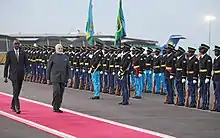
Several sources, including Gérard Prunier, document U.S. aid to the RPA before the First Congo War.[35] The officially admitted part of the training was Joint Combined Exchange Training. Prunier strongly implies the United States supplied communications equipment, vehicles, boots, and medicines to the RPA before the war began and after it broke out, delivered second-hand Warsaw Pact weapons and ammunition either directly to Goma or by airdrop along the AFDL front lines. He reports that after the war's outbreak, the U.S. Air Force had switched from using C-141 Starlifters and C-5 Galaxys to deliver the non-lethal aid to Kigali Airport and Entebbe Airport, to airdrops by C-130 Hercules aircraft.[36]
From July 1994 until December 1997 the RPA had six brigades, as designated in the Arusha Accords: 402nd in Kigali and Kigali Rurale Prefecture; 201st in Kibungo, Umatura, and Byumba Prefectures; 301st in Butare, Gikongoro, and Cyangugu Prefectures; 305th in Gitatama and Kibuye Prefectures; and 211th in Gisenyi and Ruhengeri Prefectures. The brigade boundaries mirrored the political administrative boundaries, which often complicated military operations.[37] During the First Congo War the brigade headquarters remained inside Rwanda but directed operations inside the Democratic Republic of the Congo.[38]
Jane's World Armies said in July 2009 that 'the RDF is deployed to protect the country's borders and defend against external aggression. There are four divisions, each deploying three brigades:
- 1 Division, based at Kigali, covers the central and east region;
- 2 Division, based at Byumba, covers the north and east region;
- 3 Division, based at Gisenyi, covers the northwest region; and
- 4 (Mechanised) Division, based at Butare, covers the southwest region.[39][40][41]
- Artillery Division[42]
Brigades reported include:
- Republican Guard Brigade, Kigali[43]
- Special Forces Brigade[44]
- Engineering Brigade[45]
- 201 Brigade, Kibungo[46][47]
- 204 Brigade, Gasabo District, Kigali[48]
- 211 Brigade, Gisenyi[46][49]
- 301 Brigade, Butare[46]
- 305 Brigade, Gitatama[46][49]
- 307 Brigade[50]
- 402 Brigade, Kigali[46]
- 408 Brigade, Rusizi District[46][51]
- 411 Brigade
- 501 Brigade
- 503 Brigade
- 511 Brigade, Gicumbe District
Many soldiers from the former Rwandan Armed Forces (FAR), the national army under the previous regime, have been incorporated into the RDF since 1994. This process began soon after the genocide in January 1995, when several former FAR officers were given senior positions in the new armed forces: Col. (later Gen.) Marcel Gatsinzi became the Deputy Chief of Staff of the RPA, Col. Balthazar Ndengeyinka became commander of the 305th Brigade, Lt. Col. Laurent Munyakazi took command of the 99th Battalion, and Lt. Col. (later Brig. Gen.) Emmanuel Habyarimana became an RPA Member of Parliament and Director of Training in the Ministry of Defence. Gen. Gatsinzi later became Director of Security and then Minister of Defence in 2002.[52]
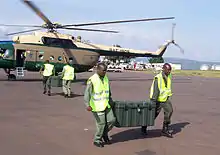
Air Force

.jpg.webp)

After achieving independence in 1962, the air arm (Force aérienne rwandaise) was formed with Belgian help.[53] By 1972 the first modern equipment started to arrive in the form of seven Alouette IIIs. Other deliveries included Aérospatiale Gazelle, Britten-Norman Islanders, Nord Noratlas, SOCATA Guerrier armed light planes and Eurocopter AS350 Écureuil. After fighting began between the RPA and the government in 1990 most aircraft were shot down, destroyed on the ground or crashed. Few survived.
Flight International's World Air Forces 2017 states the Rwandan Air Force has twelve Mil Mi-8/17 helicopters, five Mil Mi-24 and four Aerospatiale Gazelle SA.342.[54]
During December 2012 an aviation unit of three helicopters was sent to the UN Mission in South Sudan (UNMISS).[55] The Rwandan Aviation Unit was subsequently increased to six helicopters - reportedly Mi-17.[56]
Aircraft
| Type | Manufacturer | Origin | Class | Role | In service[54] | Photo |
|---|---|---|---|---|---|---|
| Mi-24 | Mil | Helicopter | Attack | 5 | .jpg.webp) | |
| Mi-8/17 | Mil | Helicopter | Transport | 12 | 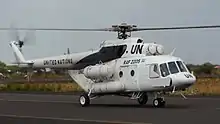 | |
| SA.342 Gazelle | Aerospatiale | Helicopter | Utility | 4 |  |
Equipment
Army equipment
Small arms
Characteristics
Marching style

%252C_Jan._16%252C_2014_140116-A-ZZ999-007.jpg.webp)
Despite not being a former British colony, Rwanda has generally used British foot drill during official parades and functions. Since 2019 however, the RDF adopted the Chinese variant of the goosestep, which is today mostly used by countries in Central and Eastern Europe, communist countries, as well as countries with a large Prussian/German influence (Russia, China and Chile all being examples of each). It was first displayed in April during the military parade in honor of the Rwandan genocide's silver jubilee on Liberation Day, in which over 1,500 RDF soldiers and policemen trained by six members of the Beijing Garrison Honor Guard Battalion of the People's Liberation Army's Central Theater Command marched while using the goosestep. It the introduction of the goosestep also saw to use of Mandarin parade commands such as "Look to the Right!" to which the soldiers respond with "One! Two!", which is done similarly in the PLA honor guard[70][71][72] Prior to this, only the rebels utilized the goosestep during the Civil War, as they received military training in the neighboring country of Uganda, which uses the goosestep.[73]
RDF Band
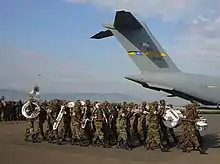
The Rwanda Defence Forces Army Band is the military band of the RDF. The RDF Band was founded in 1992 during the Rwandan Civil War and gave its first performance on 8 March 1992. After the war, it was re-established with 46 members. Although it represents the defence forces, it falls under the command of the Land Forces.[74][75]
Endnotes
- "World Defence Almanac". Military Technology. Bonn, Germany: Monch Publishing Group. XXXII (1). 2008. ISSN 0722-3226.
- "CIA World Factbook". Retrieved 23 October 2014.
- IISS 2016, p. 462.
- Rwandan Ministry of Defence, Law Establishing Rwanda Defence Forces, LAW N° 19/2002 of 17/05/2002, J.O. n° 13 of 01/07/2002
- Richard F,. Nyrop, 'Area Handbook for Rwanda,' DA 550-84, research completed April 1, 1969, p.184-185
- Des Forges, 1999, p.43
- Des Forges, 1999, p.194
- Prunier, The Rwanda Crisis, p.163, cited in Des Forges, 1999, p.118
- Alison Des Forges, 'Leave None to Tell the Story,' Human Rights Watch, March 1999, ISBN 1-56432-171-1, p.60
- See Arusha Accords, hosted at University of Ulster, pages 49-71
- Des Forges, 1999, p.124-125
- Guichaoua, André (2015). From War to Genocide: Criminal Politics in Rwanda, 1990–1994. University of Wisconsin Press. p. 251. ISBN 9780299298203.
- Des Forges, 1999, p. 264
- "The Rwandan patriotic Army and Military Commercialism in Eastern Congo" (PDF). Retrieved 2019-10-24.
- United Nations Security Council, Report of the Panel of Experts on the Illegal Exploitation of Natural Resources and Other Forms of Wealth of the Democratic Republic of the Congo, S/2001/357, 12 April 2001
- 'Militia Leader Wanted for War Crimes Killed in Congo', Voice of America (Washington, DC), 19 September 2019.
- 'Burundi rebels killed in clashes with DR Congo troops', Reuters via Defenceweb, 15 April 2019, accessed 16 April 2019, <https://www.defenceweb.co.za/security/national-security/burundi-rebels-killed-in-clashes-with-dr-congo-troops/>
- Kleinfeld, P. (2019) In Eastern Congo, a Local Conflict Flares as Regional Tensions Rise, The New Humanitarian (Geneva), 28 October 2019.
- Karuhanga, J. (2019) 'A Glimpse at Anti-Rwanda Militia Groups in Eastern DR Congo', The New Times (Kigali), 10 December 2019.
- Bishumba, N. (2019) 'Ugandans, Burundians Among Captured RNC Militia Combatants', The New Times (Kigali), 2 October 2019.
- Akanga, E. (2005) 'Sudan UN Mission Force Set to Leave', The New Times (Kigali), 20 November 2005.
- 'Rwanda deploys peacekeeping troops to the Central African Republic', Ministry of Defence website, Kigali, 15 January 2014.
- Waugh, L. (2014) Central African Republic: Will MINUSCA Deployment Make a Difference in CAR? African Arguments, 15 September 2014.
- "The Prosecutor v. Théoneste Bagosora et al., Case No. ICTR-98-41-T, Judgement and Sentence" (PDF). International Criminal Tribunal for Rwanda. 18 December 2008. pp. 32–34.
- "The Prosecutor v. Ndindiliyimana et al., Case No. ICTR-00-56-T, Judgement and Sentence" (PDF). International Criminal Tribunal for Rwanda. 17 May 2011. paras. 84–86.
- Guichaoua, André (2015). From War to Genocide: Criminal Politics in Rwanda, 1990–1994. University of Wisconsin Press. p. 279. ISBN 9780299298203.
- "Rwanda Cabinet reshuffle". Oct 19, 2018. Retrieved Sep 6, 2019.
- "Major General Murasira takes charge as the new Defence Minister". mod.gov.rw. Retrieved Sep 6, 2019.
- "Leaders". mod.gov.rw. Retrieved Sep 6, 2019.
- Munyaneza, J. (2019) 'General Kazura Replaces General Nyamvumba as Kagame Shakes Up Top Military Brass', The New Times (Kigali), 5 November 2019, <www.newtimes.co.rw/news/gen-kazura-replaces-gen-nyamvumba-kagame-shakes-top-military-brass>
- Kagire, E. (2010) ‘240 Officer Cadets Pass-Out’, The New Times (Kigali), 26 March 2010.
- Karuhanga, J. (2011) ‘Gen. Karenzi to Head Nyakinama Military Academy’, The New Times (Kigali), 23 March 2011.
- Nkurunziza, S. & Musoni, E. (2012) ‘Senior Officers College Inaugurated’, The New Times (Kigali), 24 July 2012.
- Karinganire, E.D. (2012) ‘RDF Command and Staff College inaugurated’, Rwanda Focus (Kigali), 24 July 2012.
- Gerard Prunier, From Genocide to Continental War, 2009, p.126-127 and "Archived copy". Archived from the original on 2009-10-22. Retrieved 2009-11-17.CS1 maint: archived copy as title (link)
- Gerard Prunier, From Genocide to Continental War: The "Congolese" Conflict and the Crisis of Contemporary Africa, C. Hurst & Co, 2009, ISBN 978-1-85065-523-7, p.127, citing author's direct personal observation and several interviews with journalists, both local and foreign, in Kigali and Kampala, 1995 and 1996, for the Kigali/Entebbe report, and interviews with DGSE officers, Paris, May 1997, and UPDF officers, Kampala, November 1997 for the C-130 airdrop report.
- Rick Orth (former United States Army attache in Rwanda), Rwanda's Hutu Extremist genocidal Insurgency: An Eyewitness Perspective, Small Wars & Insurgencies, Volume 12, Number 1, Spring 2001, pp. 76-109 (34), note 67, page 108
- Orth, 2001, note 67, page 108
- Jane's World Armies: Rwanda, Role and Deployment,' July 2009
- ‘RDF PRESS RELEASE - APPOINTMENTS AND CHANGES WITHIN RDF REF: RDF/MPR/A/07/02/19; 9 April 2019, <https://mod.gov.rw/news-detail/?tx_ttnews%5Btt_news%5D=4021&cHash=7d250d18dc0b30b6b85498e2d54ab37b#.XK7Y7-j7TIU>
- Munyaneza, J. (2019) ‘Gen Mupenzi Named New Army Chief of Staff, The New Times (Kigali), 9 April 2019.
- Munyaneza, J. (2019) ‘General Kazura Replaces General Nyamvumba as Kagame Shakes Up Top Military Brass’, The New Times (Kigali), 5 November 2019, <https://www.newtimes.co.rw/news/gen-kazura-replaces-gen-nyamvumba-kagame-shakes-top-military-brass>
- Cooper, Tom, Great Lakes Conflagration: The Second Congo War, 1998-2003, Helion & Co, United Kingdom, 2013.
- RDF Special Operations Forces donate blood as part of Army Week activities, Ministry of Defence Kigali, 6 May 2017, accessed 9 May 2017, <https://mod.gov.rw/news-detail/?tx_ttnews%5Btt_news%5D=3449&cHash=5d490fc2817fbc316e3ba3d313f9b5ff#.WRGyudKGPIU’>
- Munyaneza op cit.
- Cooper op cit.
- ‘19 Infantry Battalion relieved from peacekeeping mission in South Sudan’, Ministry of Defence, Kigali, 19 March 2017, accessed 20 March 2017, <https://mod.gov.rw/news-detail/?tx_ttnews%5Btt_news%5D=3401&cHash=e08c8b21684ea2e95bd7a6650c16df20#.WM-zUfmGPIU>
- 'RDF continues alternating its peacekeepers in South Sudan', Ministry of Defence Kigali, 11 March 2019, <https://mod.gov.rw/news-detail/?tx_ttnews%5Btt_news%5D=4006&cHash=bed3195e10c729b36a4349c587e45868#.XJtI5pj7TIU>
- ‘Rwanda Defence Force completes rotation for peacekeepers deployed in Zalinge – Darfur’, Ministry of Defence Kigali, 19 December 2017, accessed 28 January 2018, <https://mod.gov.rw/news-detail/?tx_ttnews%5Btt_news%5D=3659&cHash=b9ee19ed31b3250a65dd24a564384309#.Wm03eqiWbIU>
- Bizimungu, J. (2020) ‘Kagame Promotes Two Senior Military Officers’, The New Times, Kigali, 9 July 2020.)
- ‘RDF 408 Brigade get Brigade Medical Clinic’, Ministry of Degfence, Kigali, 20 August 2015.
- Orth 2001
- World Aircraft Information Files Brightstar Publishing London File 338 sheet 4
- "World Air Forces 2017". Flightglobal: 14. Retrieved 10 February 2017.
- 'Rwanda deploys Aviation Units in UN Mission in South Sudan', RDF website, 27 December 2012, viewed 13 February 2013.
- 'Female Rwandese pilots deployed with UNMISS', RDF website reprinted from UNMISS News Issue 4, 16 April 2015, viewed 20 April 2015.
- "Rwanda Rwandan army land ground forces military equipment armoured vehicle pictures information desc - Army Recognition". Retrieved 23 October 2014.
- IISS 2016, p. 463.
- Binnie, Jeremy (14 November 2017). "Rwandan SH3 self-propelled howitzer spotted". IHS Jane's 360. Archived from the original on 14 November 2017. Retrieved 14 November 2017.
- Jones, Richard D. Jane's Infantry Weapons 2009/2010. Jane's Information Group; 35th edition (January 27, 2009). ISBN 978-0-7106-2869-5.
- "Rwanda Rwandan Army ranks land ground forces combat uniforms military equipment rwandais grades unif – Army Recognition – Army Recognition". Armyrecognition.com. Retrieved 29 December 2013.
- "Arming Rwanda: The Arms Trade and Human Rights, Abuses in the Rwandan War" (PDF). Human Rights Watch Arms Project. Vol. 6 no. 1. January 1994. p. 15. Archived (PDF) from the original on 2016-03-18. Retrieved 2018-12-07.
- "Rifle R4 – Assault Rifle / Carbine – History, Specs and Pictures – Military, Security and Civilian Guns and Equipment". Militaryfactory.com. 23 May 2012. Retrieved 1 October 2012.
- "تقرير إعلامي موجز: عيارات نارية في أيدي متمردي جمهورية الكونغو الديمقراطية مصدرها اليونان والصين وروسيا والولايات المتحدة | منظمة العفو الدولية". Dec 6, 2018. Archived from the original on 2018-12-06. Retrieved Sep 6, 2019.
- "Archived copy". Archived from the original on 2016-06-29. Retrieved 2016-07-08.CS1 maint: archived copy as title (link)
- Rwanda Archived 2013-01-17 at the Wayback Machine
- Sgt. Thomas Mills (2014-01-16). "More images from Rwandan Airlift Mission". US Army Africa. Retrieved 2020-01-19.
- Albert Gonzalez Farran (2014-02-10). "WFP food distribution". UNAMID. Retrieved 2017-06-04.
- "Archived copy" (PDF). Archived from the original (PDF) on 2014-07-28. Retrieved 2014-07-20.CS1 maint: archived copy as title (link)
- "Rwandan troops trained by Chinese mark 25th anniversary of liberation". South China Morning Post. Retrieved 2019-10-24.
- "Rwandan troops trained by China mark genocide anniversary". Inkstone. Retrieved 2019-10-24.
- "Chinese guards of honor help Rwandan troops complete military parade marking liberation anniversary - China Military". english.chinamil.com.cn. Retrieved 2019-10-24.
- Parker, Allison (2002). Hidden in Plain View: Refugees Living Without Protection in Nairobi and Kampala. New York, NY: Human Rights Watch. p. 89. ISBN 9781564322814.
The RPF had very close ties with the Ugandan government as many of its leaders came from the exiled Tutsi community in Uganda and had become an important force within Museveni's rebel force ... As a result, many members of the elite in Rwanda look back on a period of military training in Uganda, and retain close links with the Ugandan military.
- "rwfacts.com - This website is for sale! - rwfacts Resources and Information". ww1.rwfacts.com. Retrieved 2019-10-24. Cite uses generic title (help)
- Kidz, Cool Classic (Feb 4, 2011). "The Rwandan Defence Force Army Band receive training from the SA Army Band Cape Town". SA Army Band Cape Town. Retrieved Sep 6, 2019.
Bibliography
- Cooper, Tom, Africa@War Volume 14: Great Lakes Conflagration, The Second Congo War, 1998-2003, Helion & Co Ltd, England, 2013.
- Dallaire, Lt. Gen. Romeo, Shake Hands with the Devil: The Failure of Humanity in Rwanda, Random House of Canada Ltd, Toronto, 2003.
- Des Forges, Alison, 'Leave None to Tell the Story,' Human Rights Watch, March 1999, ISBN 1-56432-171-1
- Fontanellaz, Adrien & Cooper, Tom, Africa@War Volume 24: The Rwandan Patriotic Front 1990–1994, Helion & Co Ltd, England, and Thirty Degrees South Publishers Pty Ltd, Johannesburg, 2015.
- IISS (2016). The Military Balance 2016. Routledge. ISBN 978-1857438352.
- Nyrop, Richard F., Brenneman, Lyle E., Hibbs, Roy V., James, Charlene A., MacKnight, Susan & McDonald, Gordon C., Army Area Handbook for Rwanda, U.S. Government Printing Office, 1969. Research and writing completed April 1, 1969.
- Orth, Rick (former United States Army attache in Rwanda), Rwanda's Hutu Extremist genocidal Insurgency: An Eyewitness Perspective, Small Wars & Insurgencies, Volume 12, Number 1, Spring 2001.
- Prunier, Gerard, From Genocide to Continental War: The "Congolese" Conflict and the Crisis of Contemporary Africa, C. Hurst & Co, 2009. ISBN 978-1-85065-523-7
Further reading
- Patrick Lefèvre, Jean-Noël Lefèvre, Les militaires belges et le Rwanda 1916-2006, Racine, 2006
- Richard Muhirwa, Rwandese Patriotic Army Logistics Unit (G4) Assessment and Recommendations for Change, Master's thesis, Naval Postgraduate School Monterey CA, 2000
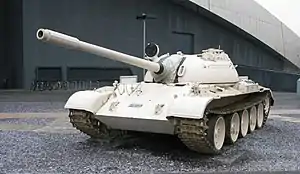
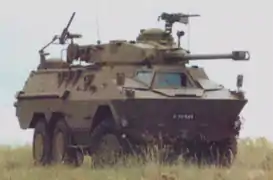
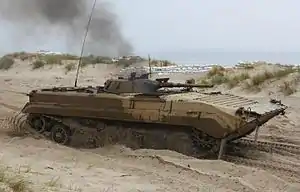
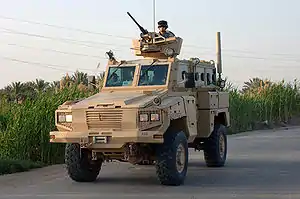
.jpg.webp)
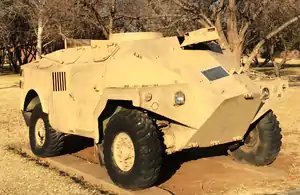
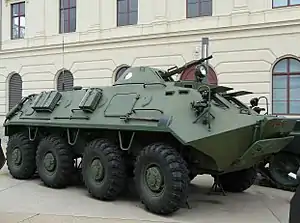
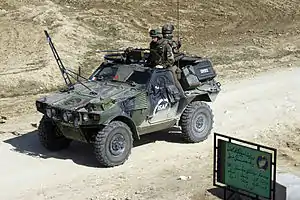
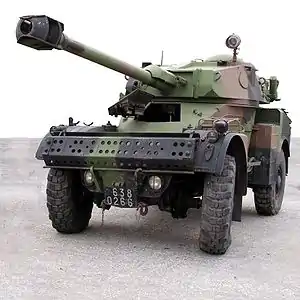
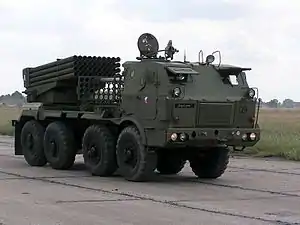
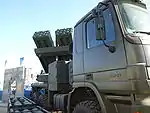
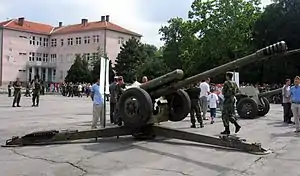

_museum_on_Sapun_Mountain_Sevastopol_1.jpg.webp)
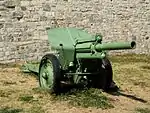
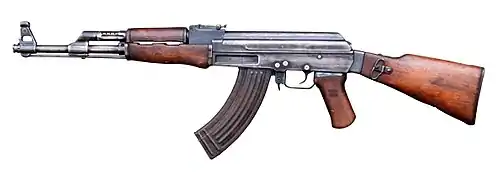




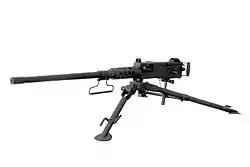
.jpg.webp)


.jpg.webp)
